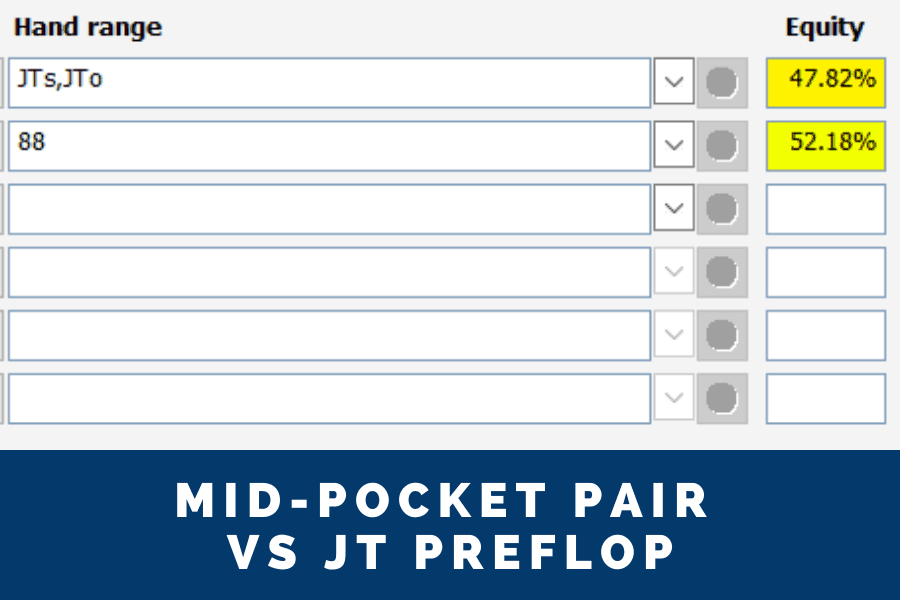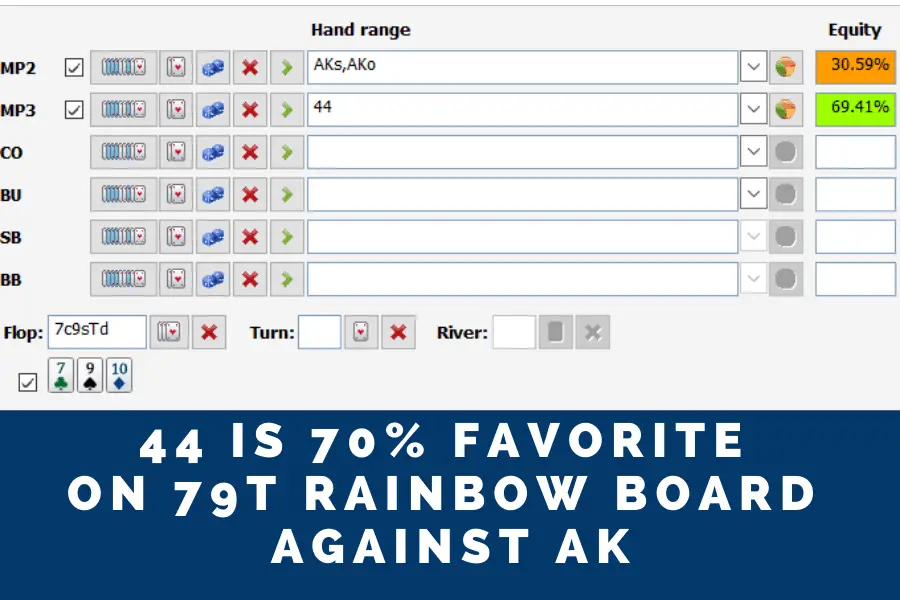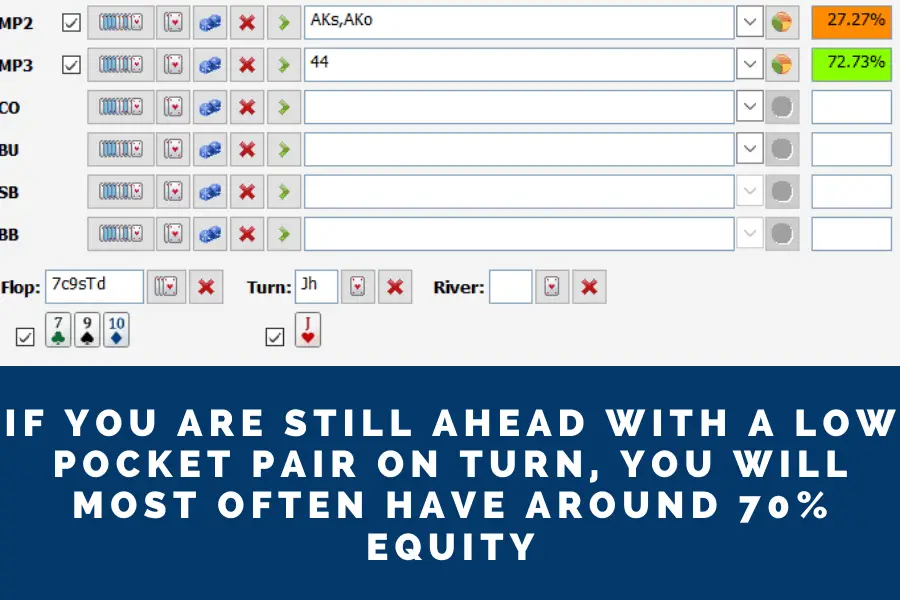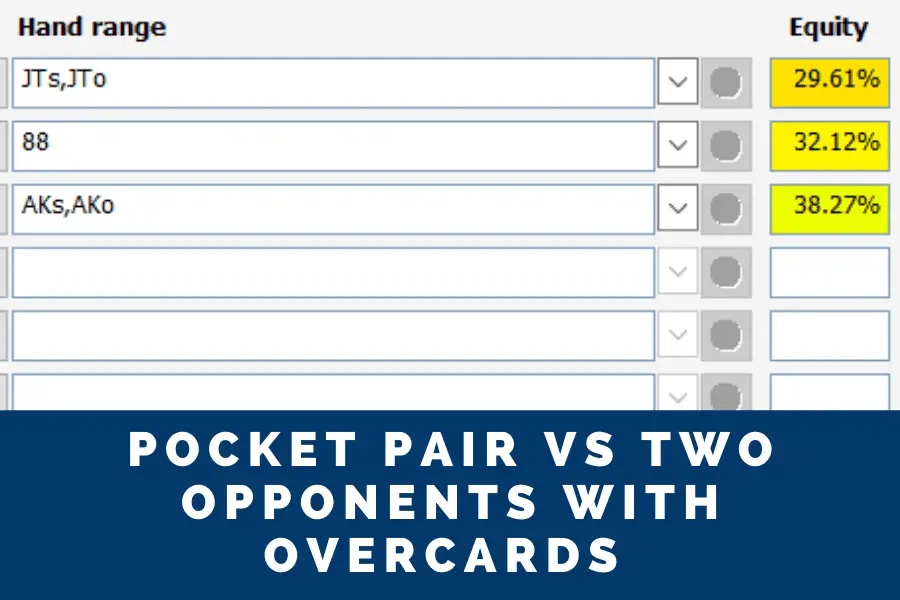I remember many scenarios when I went all-in in a poker tournament with a pocket pair and got called by a guy having two overcards. This is such a common occurrence that every slightly more experienced player will know the exact odds to win when they are against the same matchup.

Pocket pair will have slightly more than 50% odds to win against two overcards. If the opponent has a suited hand, then sometimes it gets very close to a flip (50% vs. 50%). Against offsuit overcards, a pocket pair will have at least 52.5% equity and up to a max of 56%.
Of course, this is just raw pre-flop equity, but for postflop and winrate, it matters a lot what pocket pair we have.
Just because you have a small advantage over overcards, preflop doesn’t mean you should be putting all of your chips in the middle every time you get a pair.
Higher pairs will be good enough to 3bet, while lower and mid pairs will be best off to just set mine (try to hit a set on the flop). When it really matters how high the pair is, it is postflop. QQ will be overpair almost 60% time on the flop, while 22 never.
22 is only reasonable to set mine with, while with QQ, we can extract value on many flops turns and even rivers. Smaller pocket pairs will be tough to play postflop when we are out of position. If we miss set on the flop, most often, the best play will be to check out of position. If we have the position, we can try with a continuation bet and try to take the pot.
Preflop
You can’t go too wrong and say that pocket pair against two overcards is a flip. Equity of going all-in preflop will not change a lot in any case. If we hold 22, we have 52% equity against AK, while with QQ, we have 56%. I prefer to play middle and low pairs passively and will not 3bet them. I will start 3betting for value with 99 and better, depending on the opponent.
If you are the kind of player that likes to shove preflop, it is essential to note the following. Variance can be brutal when you are not a big favorite. It is not common to lose 50 buy-ins if you were to go all-in every time you have 52% equity. If you play in an environment where the rake is more significant than 4%, this even means you are losing money (your equity – their equity – rake).
Postflop
Playing correctly with overcard on the flop in poker is essential and one of the big factors if you will make money or be a donator. If we hold AK for example we should go for a cbet, despite us having 30% odds to win only against a pocket pair. We need to put pressure on the opponent. It will be very hard for him to continue with a low pocket pair. There is plenty of opportunities to barrel on turn and river also.
But how to play the hand if we are in opposite shoes, and we hold a small pocket pair?
Our odds with a pocket pair against two overcards improve by a lot on flop. We are now often 70% favorite to win the hand. But this doesn’t help much if we don’t that the opponent is holding exactly two overcards and doesn’t have a better hand than we do already. let’s see how we should play middle pairs on the flop.
It is far better to be patient and set mine with middle pairs. It’s far less swingy and makes you way more money also. It is hard for many opponents to let go of their overcards postflop. This gives us an excellent opportunity to get value from overcards when we hit strong and even when we don’t hit a set, and we go for 1 street of value only.

AK that missed the flop has only 30% equity against 44. Even if we face three overcards on flop, we can sometimes go for 1 street of a value bet. This is a sort of value/block bet, to keep pot small on later streets. If the opponent with AK folds, it is excellent for us. If he calls, we are still the favorite to win the hand. This maneuver will be far easier to accomplish when we are in a position.
Being out of position is better to give up than build the pot, as we have a hard time on turn and river if we get called. The last thing you want to do is to build the pot on flop out of position. You will be forced to give it up on later streets often, and it will cost you a lot of chips.
| Our hand | Odds to win preflop | Odds to Win on the flop |
| Low pocket pair (44) | 52% | 70% |
| Two overcards | 48% | 30% |
Turn
If we are still good on the turn, then we are usually around 75% favorite to win the hand. Unless the board is very draw heavy, and our opponent holds a strong draw. The best play on the turn is to give up and hope for a free showdown. We don’t want to build the pot more, either in position or out of position.

River
If we have the position on the river and we didn’t improve, then we should almost always check the river. We believe we are ahead more often than not. We can’t value bet with our weak hand as we don’t get called by worse. Bluffing also doesn’t make sense if we think we might be good decent amount of the time.
When playing out of position, we are at the mercy of the opponent. We should check and hope he checks back. Anything else and we are burning money. People don’t like to fold a lot on smaller stakes, and they also don’t go for thin value bets enough.
Pocket Pair vs. 2 People or More With Overcards
In the case when we have a pocket pair, and we are against two opponents, we are not the favorite preflop anymore. Let’s examine the scenario where we have 88, and 1 of our opponents has JT and other AK, either suited or off suited combination. We now have only 32% to win, and we would need 33% to breakeven. If our pair is lower than that, then our equity drops. If we hold 22, then we have only 29.5% of equity.

When we are against three opponents, and each is having overcards, it starts to matter more and more, which overcards our opponents have. Maybe they are blocking each other’s outs, and maybe we block their straight outs, etc. But as a general rule of thumb, we will not have required 25% often.
Postflop, we should play very straightforward in multiway pots. If we have missed the flop, give up. Even in position, I would check behind. It will be unlikely that all of the opponents have entirely missed the flop. Our strategy should be to bet if we have hit a set. More opponents in the pot, the better it is for us to call preflop with pocket pair. That is because we play small and medium pocket pairs only to set mine; otherwise, we give up postflop. And when more people call our odds to set mine gets better. If we hold a good pocket pair, then the correct move is to squeeze or 3bet preflop. We want to play the pot heads up, and we also want to charge people who want to see the flop when we have the equity advantage.
I showed you equities examples with a great free software called Equilab. It is a tool with which I practiced a lot when I was just starting in poker. Unlike all other poker tools that cost a lot of money, Euilab is free. You can get it from here. Go under Poker Tools, scroll down to Free training software and download Equilab.
Conclusion
I hope I was able to present to you clearly how pocket pair does against overcards in many different scenarios. Pocket pair vs. overcards is usually close to a flip preflop, albeit pocket pair being a tiny favorite. Just remember. Being in a position is always better than out of position. Moreover, with lower pocket pairs, we might even get away with some bluffs in position. While out of position we can hope that villain will check down to showdown.
Related Articles



